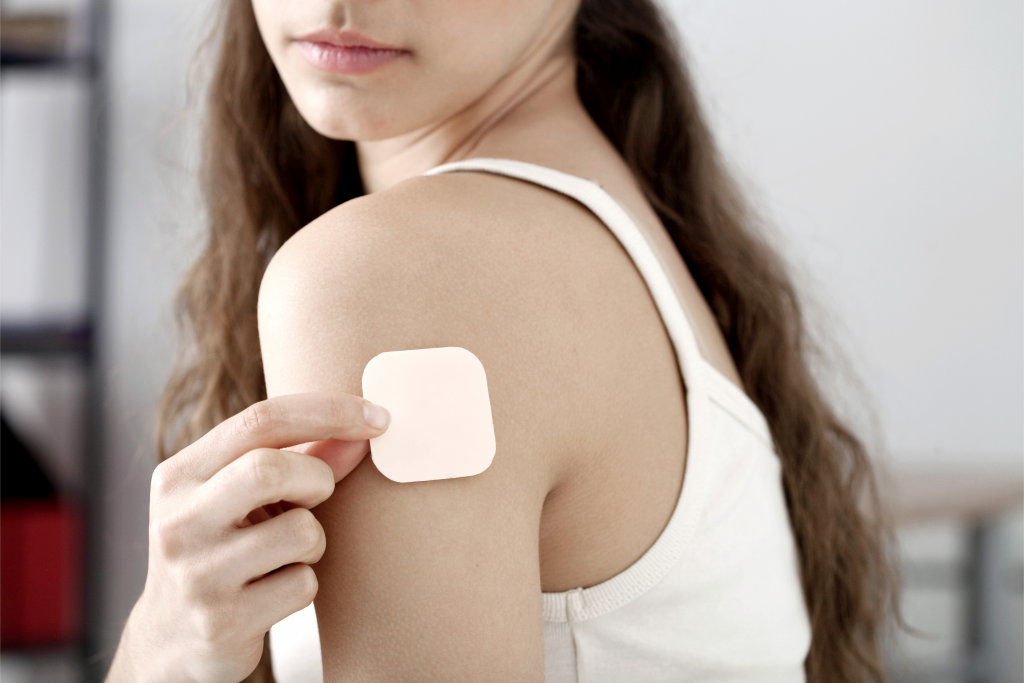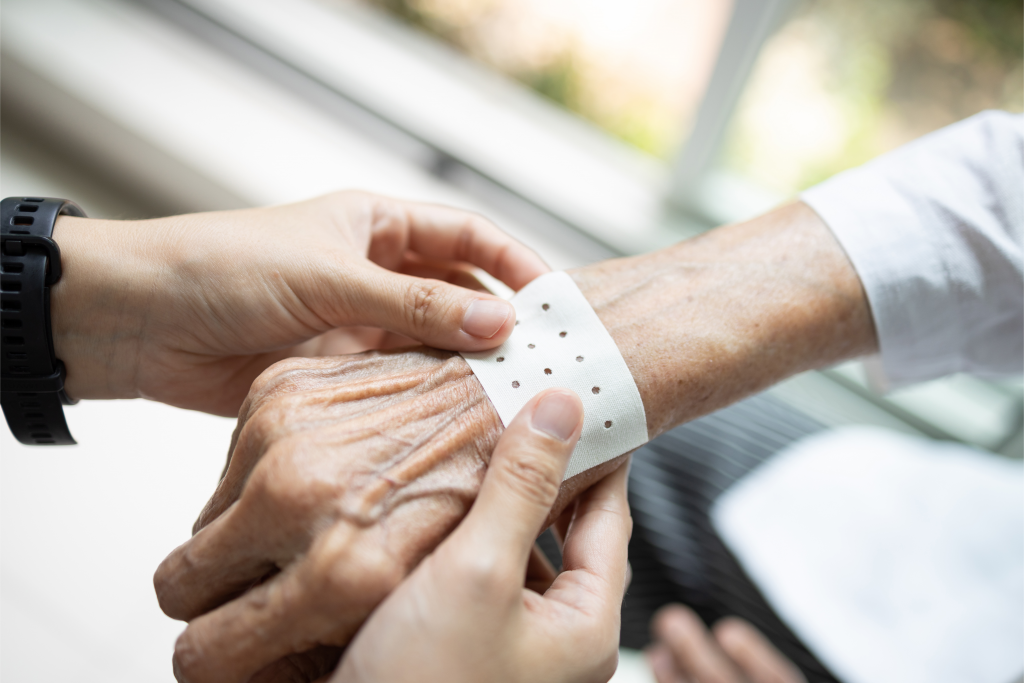With magic mushrooms and MDMA getting closer to some kind of federal legalization, its not surprising that the world of biotech is already formulating new and innovative products. What’s the latest? Different companies are working on psilocybin skin patches, which offer yet another way to benefit from magic mushrooms.
In just a few years, could psilocybin skin patches become the new norm? It sure would be interesting to get your psychedelic medicine treatment via your skin! There are already different ways of doing it, with more technological advances likely to come, and we’ll keep you up-to-date on all of it. We make sure to cover everything important in this new and groundbreaking medical field, which you can follow by subscribing to The Psychedelics Weekly Newsletter. Check out all the latest news and gain access to new deals on psychedelic products and paraphernalia, as they become available.
What are skin patches?
Skin patches can have a variety of functions, and are used in different parts of medicine as a delivery system to give treatment. For example, some people use nicotine skin patches to try to avoid smoking. Some use fentanyl patches to deal with pain in a specific location. Some slap on a patch monthly for birth control measures, some stick them on warts to make them go away, and some have other functions that are met by sticking a patch on their skin.
Called transdermal patches, this delivery system is done by absorbing medication through the skin. Patches are generally made of plastic which has an adhesive coat on it. The adhesive coat is infused with a specific amount of a medication, depending on the needs of the patient, and the amount of time the patch is meant to be worn. Patches are beneficial in many cases because they allow for slow release and absorption, which can last from a few hours, to all day. Some patches, like pain patches, are meant for a localized ailment. Some, like birth control patches, are simply a way of getting medicine into the bloodstream in general.
There are several different kinds of transdermal patches. 1- Single-layer Drug-in-Adhesive patches, that contain medication in the adhesive layer, which absorbs through the skin through contact. 2 – Multi-layer Drug-in-Adhesive patches, these include two medicine-infused adhesive layers, often separated by a membrane, with one offering immediate release, and one slow release. 3 – Reservoir System patches, which contain a separate liquid compartment within their own layer with medication or suspension, which is behind the adhesive. 4 – Matrix System patches, which have a layer of semisolid matrix which holds the drug solution or suspension. The matrix layer is surrounded by adhesive. 5 – Vapour Patches, which contain the medicine in the adhesive, but which let it out as a vapor, and can be used for essential oils.

Nova Mentis and Mycrodose create psilocybin skin patches
As research on magic mushrooms shows more and more promise for help with all kinds of psychological and medical issues, its no surprise that different delivery methods and technologies are being looked at by biotech companies. One such recent partnership holds much promise for the future of psilocybin skin patches.
The companies Nova Mentis and Mycrodose have teamed up to investigate if psychedelics can be used effectively in skin patches, particularly psilocybin for use with fragile X syndrome, a genetic disorder which causes intellectual disability. Nove Mentis created the psilocybin treatment for the condition, while Mycrodose produces the skin patch technology. While both companies have functional products, the question of how well they can be integrated together effectively is under investigation. Should it prove to be useful, this may very well be a future treatment option for fragile X, as well as other neuroinflammatory diseases.
Nova Mentis has already completed four pre-clinical studies showing the efficacy of its psilocybin treatment, and has identified therapeutic microdose levels. Nova President and CEO Will Rascan stated “This cooperative transdermal delivery technology expands the possibilities of treating chronic developmental disorders such as fragile X syndrome without exposing the child or adult to intolerable hallucinogenic side effects.”
This is because transdermal administration has the benefit of being absorbed into the bloodstream, without the issues associated with standard medications such as psychosis, liver toxicity, and larger-than-necessary dosing.
Ei.Ventures and Tioga Research also creating psilocybin skin patches
Nova Mentis and Mycrodose are not the only partnership getting in on this game. Last year Hawaiin start-up Ei.Ventures and Tioga research also announced a partnership to establish psilocybin skin patches for transdermal medicine delivery.
Tyler Strause, the project development specialist for Ei.Ventures had this to say about the benefits of this kind of new technology: “One of the unique challenges with psychedelics is managing the peak experience, where people may experience some adverse effects… By utilizing transdermal technology, our hope is that we’re going to be able to essentially flatten the curve, make the acute peek a little bit less acute and also allow for a more extended duration of the sort of threshold effects.”

Strauss also explained how “there are a range of potential, therapeutic applications from microdosing up through sort of breakthrough doses. And even, potentially, what have been sort of described as heroic doses”, showing the variable ways in which patches can be used.
The goal of the two companies is to create a spectrum of products that give patients new options for medication taking. However, they are not losing site of other aspects. Says Ei.Ventures president David Nikzad in regard to preventing misuse, “I think that the psychedelic experience at this point needs to be done with a therapist… I used to think differently about that, but I’ve seen where psychedelics can be taken and used in too much of a recreational manner.” For this reason, the companies are focusing on patches that would be used under therapeutic supervision.
What about micro-needle patches?
The types of patches listed in the first section all fit under the heading of ‘transdermal patches’, however there is new emerging technology that offers a different kind of medicinal skin patch: micro-needle patches. These patches differ in that they contain a surface layer with tons of micro-needles which enter the surface of the skin, where they biodegrade leaving medicine under the surface of the skin. The patch itself is made from a gelatinous substance.
Micro-needle patches were designed by researchers at The Terasaki Institute for Biomedical Innovation (TIBI), and can be used for a range of issues, like for gene and stem cell therapy. Says TIBI’s director and CEO Ali Khademhosseini, Ph.D., “Our microneedle technology enables one to deliver medications and treatments in a safe, easy, painless and minimally-invasive manner… It also allows for controllable delivery, using materials that are highly biocompatible and biodegradable.” They also allow for water-soluble and insoluble drugs to be used.
In February of 2021 TIBI announced a partnership with Pharma Ther, Inc., a life sciences company that specializes in R&D for psychedelic treatments. The goal is to create micro-needle patches that can be used for these treatments. Currently, the company is working on creating treatments using MDMA, LSD, DMT, psilocybin, and ketamine. As of April 2021, the company had 17 patents granted, or still out as applications, and is looking to use the psychedelic patches for neuropsychiatric, neurodegenerative, and pain disorders, according to CEO of PharmaTher., Fabio Chianelli. He also went on to say:
“We are excited to work with the Terasaki Institute and the inventors of the GelMA delivery technology, as it enables a solid foundation to expedite the product, and clinical development for a first-of-a-kind microdosing delivery system to treat serious unmet medical needs.” He went on, “Our focus is pursuing prescription-based psychedelic pharmaceuticals for FDA and international regulatory approval and unlocking the potential therapeutic value of these compounds via TIBI’s microneedle patch.”

The company is heavily into ketamine research as well, with several of its patents related to this part of the industry. The company is in the process of establishing medications for conditions like Parkinson’s disease, depression and Lou Gehrig’s disease using ketamine. For this, the company has struck up a patent and license agreement with The Queen’s University of Belfast for use of a hydrogel-forming microneedle patch delivery technology.
This patch comes with an added benefit of allowing patients to remotely dose their medication safely, without having to be directly under the supervision of a specialist, or in a medical facility at all. These micro-needle patches have hydrogel-forming micro-needles, along with a reservoir, which allows for more medication to be loaded into the needles, getting around issues of limitations in the amount of medication that can be used in a patch. They are specifically being studied with ketamine at the moment.
Conclusion
Though esketamine – a half-brother to ketamine – was quietly legalized in 2019, no other psychedelic has any federal legality at the moment, which makes it that much more interesting that this much research and technology is so far underway. It certainly says a lot about the expectation of future legalizations, and on where the market is expected to go. By the time legalizations occur, there will be full product lines out there for the public, with psychedelic medicine patches containing the likes of psilocybin and more, all ready to go.
Welcome all readers! Thanks for making it to CBDtesters.co, your top internet spot for independent coverage of cannabis and psychedelics-related news relevant to today. Join us frequently to stay educated on the exciting world of cannabis and psychedelics, and make sure to subscribe to The Psychedelics Weekly Newsletter, to keep up-to-date on everything going on.
Disclaimer: Hi, I’m a researcher and writer. I’m not a doctor, lawyer, or businessperson. All information in my articles is sourced and referenced, and all opinions stated are mine. I am not giving anyone advice, and though I am more than happy to discuss topics, should someone have a further question or concern, they should seek guidance from a relevant professional.









